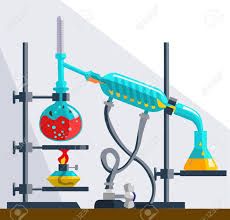Distillation, process of separating the constituents of a liquid or solid substance by vapourising all or part of it and condensing the vapours into liquid. Distillation is a technique of separation of substances that allows to separate the different components of a mixture.

This technique is based fundamentally on the boiling points of each of the components of the mixture. The greater the difference between the boiling points of the substances in the mixture, the more effective the separation of its components will be; that is, the components will be obtained with a higher degree of purity.
Distillation is widely used in the industry, allowing processes such as obtaining alcoholic beverages, refining petroleum, obtaining petrochemical products of all kinds and in many other fields. It is one of the most widespread separation processes.
Types of Distillation
Fractional Distillation
It is used when the boiling points have a difference lower than 80 ° C. When the mixture is heated, the vapor acquires more richness in the element of greater volatility, that is used to divide the liquid compounds. This type of distillation is characterized mainly by requiring a fractionation column. It can be carried out at reduced or atmospheric pressure, just as with simple distillation.
Steam distillation
It is used to purify compounds whose boiling point is very high, through the use of temperatures not exceeding 100 ° C. This type of distillation is very convenient to deal with substances that have a boiling point well above 100 ° C and that never decompose beyond the temperature.
Vacuum distillation
Another method for distilling substances at temperatures below their normal boiling point is to partially evacuate the still. For example, aniline can be distilled at 100 ° C by extracting 93% of the air from the still. This method is as effective as steam distillation, but more expensive. The higher the degree of vacuum, the lower the distillation temperature. If the distillation is carried out in a practically perfect vacuum, the process is called molecular distillation. This process is commonly used in the industry to purify vitamins and other unstable products. The substance is placed on a plate inside an evacuated space and heated. The condenser is a cold plate, placed as close to the first as possible. Most of the material passes through the space between the two plates.
Beverages Made By Distillation
The alcoholic beverages that include distillation in its elaboration process are many, and the following are distinguished:
- Whiskey :Includes all its varieties; Scottish (Scotch), Irish, American and Canadian Whiskeys. Include some aging according to its producer.
- Vodka : Eastern and Baltic Europe are made from potatoes and cereals , and Western ones from cereals only.
- Ron : Spanish rum or French Rhum. Leaving all of the sugarcane , they are grouped into three basic variants. (1) dry and light body. Produced in Cuba, Puerto Rico, Mexico, Argentina, Brazil and Paraguay; (2) those of intense body produced mainly in Jamaica, Barbados and Demerara (British Guyana); (3) Brandy but aromatictypes from Java and Indonesia, Haiti and Martinique.
- Brandy or Cognac: From the distillation of wine or fruit and aged in wooden barrels . The best known are those that have originated in France under the term cognac and is recognized as distillation of wine . Those of fruit start from apples , cherry ,apricot ( damask ), plum , etc. although they are well-known drinks not like brandy or cognac if not by the marks of the finished product or historical name that has been assigned to them.
- The Slivovitza that derive its name from the plum used (Quetsch or Mirabelle). The Barat Palinka that derives from the apricot and aged in wooden barrels . The cherry brandy that is also known as Kirsch in France and Kirschwasser in Germany and Switzerland that has no aging and therefore transparent color.
- Tequila : Obtained from mezcal or agave , varieties of cactus from Mexico and from the desert of the southern United States of North America. Its aging increases its quality. It is marketed with alcoholic graduations ranging from 37º to 50º.
- Oke (Okelehao): Part of the distillation of sugar cane molasses , rice and juice from a local fruit with which they also make a meal called Poi. It is aged in oak barrels .
- Ng ka py : It is a variety of 43º Chinese whiskey made from millet and aromatic herbs and aged in wood .
